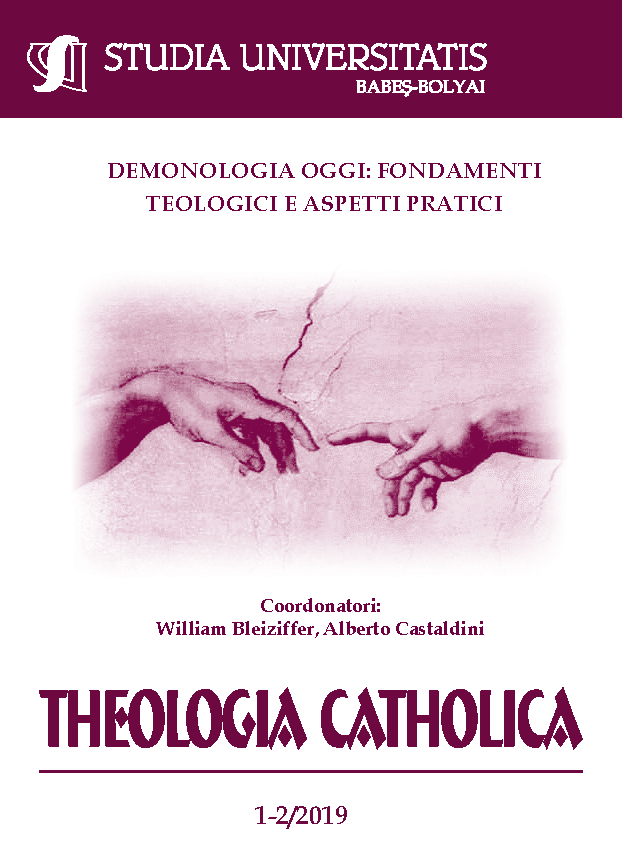L’ANTICRISTO, LA SUA PERSONALITÀ, L’ATTIVITÀ E IL SUO GRANDE POTERE DI SEDUZIONE
DOI:
https://doi.org/10.24193/%20theol.cath.2019.02Keywords:
Antichrist, apostasy, eschatological struggle, parusia, sin, man of iniquityAbstract
The Antichrist, his personality, his activity and his great power of seduction. In the literature of the New Testament we discover an evolution and a deepening of the figure of the Antichrist starting from the person of Christ and not only by his contrast with Christ. Saint Paul, in 2 Ts 2, 3b-4 speaks to us of a mysterious character, the man of iniquity, in a context in which he deals with the coming of the Lord, which precedes the imminent coming of Christ; he presents himself as a false prophet who falsifies the true revelation, being the false par excellence. In the epistles of John (cf. 1 Jn 2, 18.22; 4, 3; 2 Jn 7) the Antichrist is not only a character who will come, but has already come, is already present in the history of Christians; it is not just one but there are many antichrists who endanger the mystery of the incarnation and the Christian faith. With the same intention it is presented in Revelation (cf. cc. 12-13), through the figure of the dragon and the beast, as representations of Satan, in order to counterfeit the Christian religion. Throughout history, past, present and future, his activity and manifestation of his personality will be that of embodying all the earthly powers that, with the help of the wrong instruments and mechanisms, ideologies and dictatorships to spread separation, evil, sin and even death.
Anticristul, personalitatea sa, activitatea și marea sa putere de seducție. În literatura Noului Testament descoperim o evoluţie şi o aprofundare a figurii Anticristului pornind de la persoana lui Hristos şi nu doar prin contrapunerea sa faţă de Hristos. Sfântul Paul, în 2 Ts 2, 3b-4 ne vorbeşte de un personaj misterios, omul nelegiuirii, într-un context în care tratează despre venirea Domnului, care precede venirea iminentă a lui Hristos; se prezintă ca şi un profet fals care falsifică adevărata revelaţie, fiind falsul prin excelenţă. În epistolele lui Ioan (cf. 1 In 2, 18.22; 4, 3; 2 In 7) Anticristul nu este doar un personaj care va veni, ci a venit deja, este deja prezent în istoria creştinilor; nu este doar unul ci sunt mulţi anticrişti, care pun în pericol misterul întrupării şi credinţa creştină. Cu aceeaşi intenţie este prezentat în Apocalipsă (cf. cc. 12-13), prin intermediul figurii balaurului şi a fiarei, ca reprezentări ale lui Satana, cu scopul de a falsifica religia creştină. Pe tot parcursul istoriei, trecută, prezentă şi cea viitoare, activitatea sa şi manifestarea personalităţii sale va fi aceea de a întruchipa puterile pământeşti care, cu ajutorul instrumentelor şi mecanismelor nelegiuite, ideologii şi dictaturi, să răspândească separarea, răul, păcatul şi chiar moartea.
Cuvinte-cheie: Anticristul, apostazia, lupta escatologică, păcat, omul nelegiuirii
Downloads
Published
How to Cite
Issue
Section
License
Copyright (c) 2019 Studia Universitatis Babeş-Bolyai Theologia Catholica

This work is licensed under a Creative Commons Attribution-NonCommercial-NoDerivatives 4.0 International License.





 ©Studia UBB Theologia Catholica. Published by Babeș-Bolyai University.
©Studia UBB Theologia Catholica. Published by Babeș-Bolyai University.